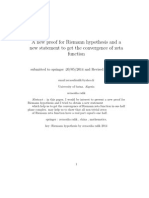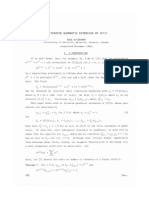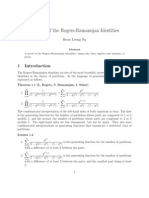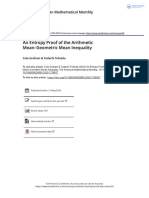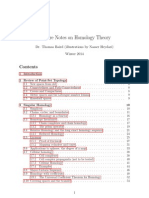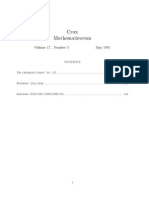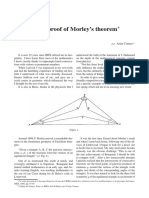TOPOLOGY IN FOUR DAYS
TADASHI TOKIEDA
Departement de Mathematiques, UQAM
C.P. 8888, succ. Centre- Ville
Montreal H3C 3P8, Canada
E-mail: tokieda@math.uqam.ca
Abstract. This is a transcription of a series of 4 lectures presented at the
Newton Institute in December 2000 to an audience of fluid dynamicists and
an astrophysicist. It explains how to use two of the simplest yet effective
topological tools: intersection number and degree of a map.
1. Solving Problems by Deformation
Example 1.1 [P6lya] We begin with a puzzle. Can you connect AA', BB',
CC' using non-intersecting curves inside the rectangle (a)?
(a. )
A
A'
If you connect AA' as in (b), it looks as if the answer is no. Let us, however,
imagine the rectangle to be made of rubber and deform it so that Band
[2J
C exchange places (c):
(c)
cl --./
The deformed problem is easy to solve (d). Deforming back (e), we obtain
a solution to the original problem.
35
R.L Ricca (eeL), An Introduction to the Geometry and Topology of Fluid Flows, 35-55.
© 2001 Kluwer Academic Publishers.
kauffman@uic.edu
�36
Solution sets of many hard problems (e.g. certain non-linear partial
differential equations) are insensitive to deformation. One use of topology
is to simplify such problems by deforming them into easier ones.
Example 1.2 For every square matrix L, det eL = etrL .
There are algebraic proofs of this identity, but here is a topological ar-
gument. First, the identity holds for diagonalizable L: if Al! ... , An denote
the diagonal entries after diagonalization, both sides equal eAl +.. +An. Now
generic matrices are diagonalizable: a small enough perturbation of a diago-
nalizable matrix is still diagonalizable, and every non-diagonalizable matrix
is a limit of diagonalizable ones. (Indeed, a matrix L whose characteristic
polynomial XL has only simple roots is diagonalizable, and generic polyno-
mials have only simple roots: when the coefficients are perturbed, multiple
roots disintegrate into simple ones.) To establish the identity for possibly
non-diagonalizable L, express it as a limit of diagonalizable matrices; the
identity holds for each of the latter, so by continuity it holds for L as well.
Problems tend to be more tractable in the generic case. Then we can
try to approach the singular cases by continuity.
Example 1.3 [Cayley-Hamilton] XL(L) = o.
Mimic the argument above.
Remark 1.4 In 1.2 and 1.3, the argument relies on working over (J;, using
as it does the possibility of splitting a polynomial into linear factors. But
the resulting identities are combinatorial relations between the entries of
L, so they remain correct over any commutative ring.
Motto 1.5 Deform the problem. Look at generic cases.
2. How to Build Manifolds
The smooth spaces, or manifolds, that we encounter most commonly in
applications are manufactured from a few basic building blocks.
Building Blocks 2.1
n-ball Dn = {(Xl! ... ,xn ) E m I 1},
(n - l)-sphere sn-l = {(Xl! ... , xn) E miL = 1},
unit interval I = IO, 1].
In the contemporary mathematical dialect, it is customary to distinguish
between balls (solid) and spheres (shells only).
Symbols 2.2
8 stands for boundary: sn-l = 8Dn.
means homeomorphic, i.e. 'topologically the same': I Dl.
kauffman@uic.edu
� 37
The building blocks of 2.1 generate complicated spaces in various ways:
product, quotient, surgery.
Method I: Product
Example 2.3 n-cube In = I X •.. X I Dn.
1 12 13
'-.-'
n
Example 2.4 n-torus Tn = SI X . • . X SI.
--.--
T2
n
surface of a mug
[) knotted tube.
Remark 2.5 In 2.4, the knotted tube is not 'deformable' in space to T2 .
Homeomorphism is weaker, and more primitive, than deformability (cf. 3.9
infra).
Method II: Quotient (alias identification)
Example 2.6 In Dn, identify all points on {)Dn:
Example 2.7 In 12 , identify (O,y) ..... (l,y) and (x,O) ..... (x,l):
Or identify (0, y) ..... (1,1 - y):
Mobius strip
(non-orientable) .
The result of identification (0, y) ..... (1, y) and (x, 0) ..... (-x, 1) is called the
Klein bottle.
Problem 2.8 What sort of object do you get when you cut a Mobius strip
along its center (= 1/2) line? along its 1/3 line?
kauffman@uic.edu
�38
Example 2.9 In sn, the antipodal identification i - i results in
IRpn = sn / , real projective space
(orient.ble for n odd, non-orientable for n even).
Other ways of describing IRpn:
0
IRpn = (IRn +! \ 0)/ ex , where ex identifies proportional vectors, i.e.
• IRPn = {lines in IRn +1 through tbe origin}.
In nn, antipodally identify points of ann (contrast 2.6) to get IRpn.
ignore north half IrA
V • In particular, IRpl SI.
Example 2.10 Complex projective space cvpn = (CV n +! \ 0)/ ex, where ex
identifies complex proportional vectors (orientable for all n).
Another way: instead of taking the quotient by identifying ex re ifJ z z,
we can first restrict CV +! \ 0 to s2n+l = {z E <r +l II z I = 1} and
n n
identify z
ex eifJ z.
Vp E cvpn,
1r-l(p) circle {e ifJ I 0 () < 21r}.
This is the Hopf fibration of s2n+l
over <r pn with fiber SI.
This turns out to be the natural geometric model of a harmonic oscillator
whose eigenvalues are all equal.
<r pI S2, Riemann sphere.
Method III: Surgery (alias cut and paste)
kauffman@uic.edu
� 39
Example 2.11
E:::2':' " - ::3 Riemann surface of genus g, = = S2.
9
top view
tetrahedral tube
f3
1 paste 1 2
Example 2.12 a( c::::-c::7 ) = S --- S = aD :
E1
Thus, if on Eo\ disk ()we put a lid with a disk, we get S2 = S2#S2 (S2
behaves like zero for #), but with a Mobius strip, we get ffip2.
More generally, paste 9 Mobius strips on to Eo \g disks to get N g (non-
orient able surface). This surface appears to have no traditional name.
Theorem 2.13 (Mobius) Any closed surJace one oj Eg or Ng.
Problem 2.14 When you paste 2 Mobius strips together, you must get
one of the surfaces in the classification 2.13. Which one? (In other words,
calculate ffiP2#ffiP2.) Develop a calculus that tells which surface you get
when you drill holes in any surface and put lids on some with disks, on
some with Mobius strips.
slicing a Klein bottle
3. Homotopy
Now we give names to two kinds of deformation: one kind allows self-
crossings, the other kind does not.
kauffman@uic.edu
�40
Definition 3.1 Submanifolds Po, PI of a manifold Mare homotopic in M,
Po '" PI, if they can be continuously deformed into each other within M
via intermediate stages Pt allowing self-crossings.
Aside 3.2 The 'definitions' in this article are deliberately designed to fall
short of the standard of formal precision among mathematicians. It is hoped
that they thereby gain in psychological digestibility.
Example 3.3
tfi:o]
M R3
trefoil knot K. - K,
K. 1<,
self-crossing
Example 3.4
M", Tl
C. Go _ G1 but G1 _ G, in T' even allowing ..,]f-
crossings. G,
Definition 3.5 If the deformation can be achieved without self-crossings,
Po, PI are isotopic in M.
Example 3.6 In 3.3, Ko and KI are not isotopic in IR3.
Remark 3.7 The concepts of homotopy and isotopy depend on the ambi-
ent space M.
In 3.3, if we replace M by IR4 , Ko and KI become isotopic.
( _ \ => _l_ by lifting into the 4th dimension; thus knot the-
ory I ')
is interesting only in 3-dimensional manifolds.)
In 3.4, if M = IR3
lV
,G1 and G2 become homotopic (even
isotopic).
kauffman@uic.edu
� 41
Problem 3.8
In IR3 , these surfaces (E 2 )
are homotopic. Are they iso-
topic?
Summary 3.9
isotopic :::::} homotopic :::::} homeomorphic.
The converses are false. 'Isotopic' and 'homotopic' are extrinsic concepts
(3.7), whereas 'homeomorphic' is intrinsic.
4. Intersection Number
All the topological tools that we develop in these lectures are based on the
idea of when geometric objects intersect and when they don't, and of how
to make an intelligent count of the number of intersections when they do.
Example 4.1 How many intersections? When tallying, let us agree to take
orientations into account.
... :/.
',p +1-1+1=+1
Q :
Q
PoQ = +1 PoQ =-2 PoQ=?
+1
Definition 4.2 Submanifolds P, Q of complementary dimensions in a man-
ifold M (dim P + dim Q = dim M) are transversal if they intersect at
nonzero angles (synonym: in general position).
Example 4.3 In M = IR3
(b) .••... _
bad point
transversal not transversal not
Principle 4.4 Transversal intersections are generic: they are robust un-
der perturbations. In contrast, non-transversal intersections are not generic:
under perturbation they become transversal ((b)-(c), (d)-(a) or (c) in
4.3) or disappear ((b)-(a) ibid.).
kauffman@uic.edu
�42
Remark 4.5 There is a concept of transversality for submanifolds of gen-
eral (not necessarily complementary) dimensions; we will not need it.
For reasonable P, Q in M, we expect dim (P n Q) = dim P + dim Q -
dim M, so that in the scenario of 4.2, P and Q intersect in a discrete (0-
dimensional) set of points.
Definition 4.6 In an oriented manifold M, let P, Q be closed oriented
transversal submanifolds. The intersection number of P and Q is
PoQ = L sgnx,
xePnQ
where sgn x = +1 or -1 accordingly as the joint orientation of P and Q
(in this order) matches or not the orientation of M at x.
If P, Q are not transversal, first 'shake' them into general position and
then compute P 0 Q.
Generalization 4.7 To do this theory in the unoriented case, count mod
2 (cf. 4.14 infra).
Fact 4.8 P 0 Q = (-1 )pq Q 0 P, where p = dim P, q = dim Q.
Is this clear? Say the orientation of P is given by a basis (frame)
UI, ••• , up, and that of Q by VI, ••• , v q • The joint orientation of P, Q is given
by Ul!"" up, VI"" v q , while that of Q, P is given by V}, ••• , V q , UI ••• , up.
To rearrange the first into the second, we need pq swaps.
Theorem 4.9 The intersection number is homotopy-invariant: if Qo fV
QI, then Po Qo = Po QI' In particular, in 4.6, Po Q does not depend on
the way we 'shake '.
Proof. Apply 4.4. While Qt is transversal to P, Po Qt
does not change. When we go through a moment of
non-transversality, we either create or annihilate a pair
of intersections with opposite signs:
(9 4==>
(9 .4=> "'0
+1-1 PoQ=? 0
so Po Qt remains unchanged, too.
QED
kauffman@uic.edu
� 43
Comment 4.10 4.6 requires closedness of P and Q to prevent intersections
from falling off boundaries without cancellation.
=> LJ", "/0
transversal, should be ±1 ouch!
Remark 4.11 It can happen that Po Q o and yet P and Q are not
'unhookable' by homotopy.
Of course, if they are 'un-
hookable', then Po Q = O.
-1 + 1 =0
Theorem 4.12 In m,n, closed submanifolds are always 'un-hookable' and
so have intersection number = O.
Proof·
homo tope apart P' or
4J ;U
tiny, tiny cat
shrink away one of
the submanifolds.
QED
Corollary 4.13 Every closed hypersurface H (of dimension n - 1) in m,n
separates mn into two parts.
n = 2 gives the Jordan
curve theorem. It isn't
all that obvious:
Proof. If not, two nearby points x, y opposite each
other across H can be joined by a curve that avoids
H. Add a bridge between x and y to form a loop
'Y. Then 'Y 0 H = ±1, contradicting 4.12.
"
QED
kauffman@uic.edu
�44
Comment 4.14 Even if His unoriented, our proof goes through with the
mod 2 theory (4.7).4.13 then implies that every closed hypersurface in IRn
is 2-sided, hence orientable.
4.12 and 4.13 hold also on sn
(n :2: 2) thanks to the shrink-away method
(d. second proof of 4.12).
Example 4.15 IRp2, being non-orient able (2.9), cannot be realized as a
surface in IR3 without self-intersections.
It is tempting to picture manifolds as high-dimensional surfaces floating
in some space. 4.15 shows that we must be careful. How much elbow room
do we need to legitimize our picture?
Theorem 4.16 (Whitney) Every closed manifold of dimension n can be
realized as a submanifold of m2n.
5. Fixed Point Theorems
Solving any species of equation (differential, integral, algebraic ... ) amounts
to finding fixed points, via the following dictionary:
solve f(x) = 0 <==> find fixed points of the map x t--t x + f(x).
The fixed point problem, in turn, can be translated into the language of
intersection theory.
Example 5.1 Suppose f is continuous and -x ::; f(x) ::; 1 - x on I. Is
f( x) = 0 solvable?
o I Visibly yes.
-)! i
Alternatively, x t--t x + f( x) maps I to I. And a con-
tinuous map I -+ I must have a fixed point where its
graph r(J) intersects the diagonal fl.J = {(x, x) I x E
I} C I X I.
Recipe 5.2 The procedure of 5.1 is typical. To solve f(x) = 0:
( 1) get an a priori estimate on f;
(2) use (1) to determine the set on which the map x t--t x + f(x) acts;
(3) apply some fixed point theorem (locate fl. n r(J».
kauffman@uic.edu
� 45
Example 5.3
f( rotation of S1 by a == 0 mod 211")
no fixed point
S'1ffflI Il = +
'Id1iJ,.
n - 1 fixed points
Announcement 5.4 From now on we suppose M closed and oriented.
Then so is M X M.
Definition 5.5 A map f : M --+ M whose graph f(J) is transversal to
!:l.M is generic.
h(Xl, ..:.. ,Xn) ).
Definition 5.6 Write a generic f in coordinates as (
fn(X1"'" xn)
The Lefschetz number of f is
L(J) = l:
x fixed pt of f
sgn det
J
-0;) x
S1 --+ S1 )
Example 5.7 L ( n = n - 1.
Theorem 5.8 (Lefschetz) If f is generic, then L(J) = !:l.M 0 f(J).
kauffman@uic.edu
�46
Proof. In dimension 1.
This corresponds to 1x - 1 > o.
This corresponds to 1x - 1 < o.
QED
QED
Corollary 5.10 (Brouwer) Every continuous map f : Dn -+ Dn has a
fixed point.
Proof. Regard Dn as the southern hemisphere of sn and consider the north-
to-south folding 9 : sn -+ Dn.
s"{@.'.'-..,-
..
.
/
Dn
A.
The composed map S n -+ 9 D f Dn inclusion
n -+ . d elorma
----+ S n IS r ble to a constant
map (e.g. shrink f(Dn) to the south pole). By 5.9 it has a fixed point which,
located on the southern hemisphere, is also fixed by f.
QED
Warning 5.11 For us, Dn contains all its boundary points (2.1). 5.10 is
®
false on open balls.
dim!:x
kauffman@uic.edu
� 47
Example 5.12 [Perron-Frobenius] A square matrix with positive entries
always admits an eigenvector whose components are all positive.
F?r it a map on the quadrant' and hence,
VIa prOJectIOn, on {(Xl, ... ,x n ) E IR I each Xk O,LXk =
I} Dn-l.
Example 5.13 [Poincare return map]
Any flow on Dn X Sl (when n = 2, solid torus) that has
everywhere nonzero angular velocity around Sl must
contain a periodic orbit.
6. Equilibria of Vector Fields
Vector fields and their equilibria (stagnation points) are fundamental in
fluid dynamics. We study them by translating them into the language of
intersection theory. This section is parallel to section 5.
Reminder 6.1 The tangent bundle over a manifold M is the manifold
T M = UxEM TxM, where TxM = tangent space to
M at X, endowed with the natural locally product
topology. (Not to worry about the jargon.)
Picture 6.2
Locally a product (it is traditional to
draw TxM perpendicular to M), but
seldom globally. A point of T M is a
pair (x, v), where x E M and v E TxM.
dimTM = 2dimM .
Remark 6.3 A vector field v on M can be thought of as a map
M ---+ TM
v:
x 1---+ (x, vex)). ",-0
Its graph r( v) intersects the zero section r( 0) M in places where
v = 0, i.e. at equilibria of v.
kauffman@uic.edu
�48
Announcement 6.4 From now on we suppose M closed and oriented.
Then TM is oriented, too (but open in the 'vertical' direction (cf. 6.2».
Definition 6.5 A vector field v whose graph r(v) is transversal to r(O) is
generic.
Vl(Xl, ':."" xn) ).
Definition 6.6 Write a generic v in coordinates as (
vn(xt, ... , xn)
The index of v at an equilibrium x is
indexv(x) = sgn det ( t
Example 6.7
l\lj'
..f-
+
}I \t,.
__ source:
index=+ 1
_0/t"- .sink:
d
III ex= +
1 _0-
..J t
'It
saddle:
index=-1
not generic: shaken into S,
0j .center:
{r
or both index= +1
Theorem 6.8 If v is a generic vector field on a manifold M, then
L indexv(x) = r(O) 0 r(v).
x equilof v
Proof. In dimension 1.
B r(v)
r(o)
This corresponds to . dv
,I.e. ax> 0.
This corresponds to ,I.e. ax
. dv < 0.
L:::::1 rtV)
QED
Corollary 6.9 I:x equil of v index v (x) does not depend on v, but only on
M.
kauffman@uic.edu
� 49
Proof. Apply 4.9: any two vector fields v, ware deformable into each other
via (1 - t)v(x) + tw(x), so rev) r(w). I"V
QED
Corollary 6.10 If dim M = odd, then L:x equil of v index v (x) = o.
Proof. By 4.8, and because rev) '" reO),
(_1)(dimM)2r(v) 0 reO) = reO) 0 rev) = rev) 0 reO).
QED
Definition 6.11 Given an n-dimensional manifold M, triangulate it with
(30 vertices, (31 edges, (32 faces, ... , (3n n-dimensional tetrahedra. (In phys-
ical applications, manifolds are usually triangulable.) The Euler charac-
teristic of M is
n
x(M) = I) -ll(3k.
k=O
Example 6.12
X(S1) = x( .6 )= 3 - 3 = O. In general, X(sodd) = o.
X( S2) = X( ) = 4 - 6 + 4 = 2. X( seven) = 2.
= 2 - 2g, X(Tn) = 0, X(<cpn) = n + l.
Theorem 6.13 (Hopf) For every generic vector field v on a manifold M,
L indexv(x) = X(M).
x equil of v
In particular, X( M) is independent of the choice of triangulation, and the
sum of indices at equilibria is independent of v.
Proof. In dimension 2. Triangulate M and construct
a vector field as follows: source at each vertex, sad-
dle at each mid-edge, sink at each mid-face. By 6.7,
source and sink each contribute +1, saddle -1 to
the index.
QED
Problem 6.14 By examining the gradient flow of a height function, find
(cf. 6.12).
Corollary 6.15 For generic v, the number of
equilibria of v IX( M) I; e.g. seven cannot carry
an everywhere non-zero vector field.
kauffman@uic.edu
�50
Problem 6.16 Construct an everywhere nonzero vector field on each sodd.
Problem 6.17 Can S4 carry a Minkowski metric without any singulari-
ties?
Corollary 6.18 For odd-dimensional, closed, orientable M, X(M) = O.
Proof. Combine 6.10 and 6.13.
QED
7. Degree Theory
Once we discover that solutions or equilibria exist (sections 5 and 6), the
next issue is to count their number.
Example 7.1
@
deg = +2 , , deg = -3
This map 'wraps' twice. 'Wraps against' thrice.
Pi
.. , ,
.
, . , \
I' .
. '/.I
; . i i-
= +1
I ,
6
! i deg deg= 0
c::: )""):
t
......
'Essentially' once.
(deg = the number of inverse images counted with sign.)
Definition 7.2 Let f : M -. N be a map between closed oriented manifolds
of equal dimension. Suppose Yo E N is a regular value of f, i.e. at each
of its inverse images det( of/ax) ::j:. O. The degree of f is
degf = L sgndet .
xEf- 1 (yo) x
Remark 7.3 There is a theorem due to Sard guaranteeing that for every
smooth f, vol {regular values of J} = volN; in other words, if we pick a
value in N at random, it will be regular with probability 1. So there exist
plenty of regular values to choose from.
kauffman@uic.edu
� 51
Note that according to the phrasing of 7.2, a point outside the range of
fjs automatically ('vacuously', as mathematicians say) regular.
Theorem 7.4 deg does not depend on the choice of regular value Yo, and
is homotopy-invariant.
Proof. Denote by fo the constant map M ---t Yo. deg f is just f(Jo) 0 f(J).
The claim follows from 4.9.
QED
Example 7.5
Over .e:;;? 3 inverse images of sgn +1, -1, +1.
Over / not regular.
(By the way, area(// / ) = 0 as Sard predicts.)
Elsewhere 1 inverse image of sgn +1.
Hence deg = +1.
Example 7.6
coot>
7l I
""'.>
)
1
Example 7.7 The antipodal map on sn preserves orientation if and only if
n = odd. So deg(antipodal)= (_l)n+l. It follows from 7.4 and 6.16 that the
antipodal map on sn is deformable to the identity if and only if n = odd.
Generalization 7.8 To do this theory in the unoriented case, count mod
2 (d. 4.7).
Corollary 7.9 (Gauss) Every polynomial fez) = anzn + ... + alz + ao,
n > 0, has a root in C.
Proof. Since lim z -+ oo f( z) = 00, f extends to a map from U{ oo} pI
8 2 to 8 2 • Now deform f to g(z) = anz n via tg(z) + (1 - t)f(z). By 7.4,
deg f = deg 9 = n (all values are regular except 0 and 00), so 0 must have
an inverse image. QED
Remark 7.10 Thus, algebraic degree of a polynomial degree in our
sense.
kauffman@uic.edu
�52
Comment 7.11 In the proof of 7.9, why couldn't we deform J to any old
thing h(z) via th(z) + (1- t)J(z)? Because if the leading terms of hand J
differ, this deformation produces a discontinuity at 00.
The mod 2 theory (7.8) detects a root only when n == 0 mod 2, i.e. n =
odd.
8. Gauss Map
We finish by sampling some applications of degree theory to differential
geometry of surfaces.
Definition 8.1 Let v be a vector field that is nonzero near a hypersurJace
H oj mn. Write
G= 1:1: H -- sn-l (Gauss map).
The degree oj v on H is degH v = deg G.
Example 8.2 In m?
Example 8.3 In IR3 , v = outward unit normal on H,
these parts contribute +1 each
-;, \
"-® G S·-1
deg = +1 + 1 - 1= +1
'v
\ H "-
, this part -1
Theorem 8.4 (Brouwer bis (cf. 5.10» Every continuous map J : nn ---t
nn has a fixed point.
ProoJ. Construct a vector field v on nn by drawing
v(x) from each x E nn to J(x). No fixed point
means v =F 0 everywhere. On ann, v points inward,
so degcwn v =F 0 (= (_l)n in fact, 7.7). Now shrink
ann to a tiny (n - 1)-sphere S C nn. If S is small
enough, v on S is nearly parallel, so degs v = 0,
contradicting the homotopy-invariance (7.4).
QED
kauffman@uic.edu
� 53
Fact 8.5 The standard volume form on sn-l can be written
n
n = 2) -l)kxkdxl A··· A A··· A dx n .
k=l
(vol(sn-l) = fsn-l n = 2-jin jr(nj2), if we must know.)
Theorem 8.6 If v is the outward unit normal vector field on a hypersur-
face H of IIr', then
degH v = k J( dO' , K large:
} normals dispersed
where J( = Gaussian curvature (prod- , __ : -# l K small:
uct of principal curvatures) of H, and I normals aligned
dO' = (n - 1 )-dimensional volume ele-
ment on H induced by the ambient eu-
clidean metric on IRn.
Proof.
de
gH
v = deg G r
vol(sn-l) lsn-l
n = 1
vol(sn-l) lH
r
G*n = 1
vol(sn-l) lH
r
J( dO' .
'
the second equality comes from the Jacobian formula for the change of
variables (fsn-l n = fH G*n if Gis I-to-l, but here Gis degG-to-l).
QED
Reminder 8.7 For H parametrized by
then
Example 8.8 For a loop 'Y in IR 2 , v= fry J( ds = rotation number
of 'Y.
rot#= +1
kauffman@uic.edu
�54
Corollary 8.9 (Gauss-Bonnet)
217r r
J'E g
Kdcr=x(E g).
Proof·
By homotopy-invariance (7.4), deforming Eg
into the position shown does not affect deg G,
-G
hence not the integral either (8.6). Vnorth is a
regular value of Gj its inverse images are the
maximum and the 9 'upward' saddles of Eg • By
8.3 they contribute +1, -1 each to degG. Hence
by 8.6 and 6.12,
-.!:...
47r
r Kdcr = 1- 9 = X(Eg)
J'E g 2
.
QED
Remark 8.10 We derived 8.9 for Eg C IR3 , but it can be shown to be
correct even in cases where the metric on Eg is not induced by an ambient
euclidean metric.
Corollary 8.11 Eg of genus 9 > 1 (respectively 9 = 1, 9 = 0) cannot carry
a metric of everywhere positive (respectively non-zero, negative) curvature.
9. Suggested Reading
A beautiful book at a similar level as these lectures is [4]. [3] is a system-
atic textbook. [5] is semi-popular and entertaining. For further topics in
topology, [7] is recommendedj [2] is heftier and covers more. For fluid dy-
namicists, a natural sequel to these 4 days would be infinite-dimensional
topological methods in partial differential equationsj they are nicely ex-
plained in [8]. The practical calculation of topological invariants requires
algebraic machinesj an efficient little book is [6]. And every graduate stu-
dent in geometry and topology seems to have read [1].
Acknowledgements
Thanks are due to K. Moffatt, H. Aref, D. Mackay, R. Ricca, and E. Spiegel
for their kind hospitality in Cambridge and generous feedback.
kauffman@uic.edu
� 55
References
1. Bott, R. & Tu, 1. (1982) Differential Forms in Algebraic Topology. Springer.
2. Dubrovin, B.A., Fomenko, A.T. & Novikov, S.P. (1984-1990) Modern Geometry:
Methods and Applications. Volumes I-III, Springer.
3. Guillemin, V. & Pollack, A. (1974) Differential Topology. Prentice-Hall.
4. Milnor, J. (1965) Topology from the Differentiable Viewpoint. University Press Vir-
ginia.
5. Prasolov, V.V. (1994) Intuitive Topology. Amererican Mathematical Society.
6. Sato, H. (1999) Algebraic Topology: An Intuitive Approach. American Mathematical
Society.
7. Schwarz, A.S. (1994) Topology for Physicists. Springer.
8. Smoller, J. (1994) Shock Waves and Reaction-Diffusion equations. Springer.
kauffman@uic.edu















